The 10th Division was a division of the Australian Army, which served briefly during World War II. It was initially formed on 15 April 1942 from the Militia units of the Newcastle Covering Force. However, personnel shortages led to the division being disbanded in August that year.
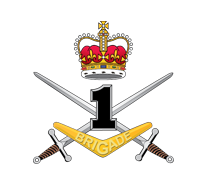
1st Brigade is a combined arms formation of the Australian Army. Formed in 1903 as a militia formation based in New South Wales, it was reconstituted as part of the Australian Imperial Force in 1914 for service during World War I, the brigade fought at Gallipoli and on the Western Front before being disbanded in mid-1919. In 1921, the 1st Brigade was re-raised as a unit of Australia's part-time military forces, based in New South Wales. During World War II the brigade undertook defensive duties before being disbanded. In 1948, it was re-raised as an integral part of the Australian Regular Army. Currently the brigade is based at Robertson Barracks in Darwin and at RAAF Base Edinburgh near Adelaide, South Australia. It is the first of the Australian Army brigades to be re-organised as a combat brigade under Plan Beersheba.

III Corps was an Australian Army unit during World War II. It was responsible for the defence of Western Australia in 1942–1944. The corps was formed in April 1942 from Western Command, which had been established in October 1939. Throughout the war, the formation's size expanded and contracted as available manpower, and the strategic situation, dictated. At its height, the corps consisted of two infantry divisions and one armoured division, which were deployed to defend against a Japanese invasion threat, which ultimately never eventuated. The corps ceased to exist in June 1944 when it was converted back into Western Command, which remained until the end of the war in 1945.

The 3rd Armoured Division was an armoured unit of the Australian Army during World War II. Originally raised in 1921 as the 1st Cavalry Division, the formation had been converted into a motor division in early 1942, before adopting the armoured designation in November 1942. A Militia formation, the division undertook garrison duties in New South Wales and then Queensland and did not see combat before being disbanded in late 1943 and early 1944.

II Corps was an Australian Army corps, one of three that were raised by the Army during the Second World War. Formed in mid-1942 as part of defensive measures to protect the eastern coast of Australia from invasion, the corps was initially composed mainly of home defence troops drawn from the Militia. For a brief period in 1942, a US infantry division was also assigned to the corps prior to its dispatch to fight the Japanese in New Guinea.

Northern Territory Force was an Australian Army force responsible for protecting the Northern Territory during World War II. Most units assigned to the Northern Territory Force were based near Darwin and were responsible for defending the important naval and air bases in and around the town against a feared Japanese invasion. Northern Territory Force was briefly renamed the 12th Division in late 1942 but this was short-lived. Australian Army units were rotated through northern Australia during the war and six infantry brigades served as part of Northern Territory Force between 1942 and 1945. The formation was reduced over the course of the war as the strategic situation in the Pacific turned in the Allies' favour, although remnants remained until the end of the war. In early 1946, it was converted back to the 7th Military District.
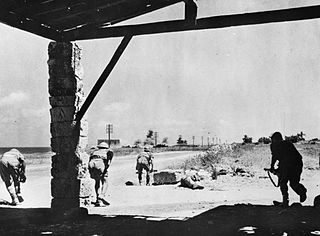
The 17th Brigade was an infantry brigade in the Australian Army. First raised in 1912 as a Militia formation to provide training under the compulsory training scheme, the brigade was later re-raised as part of the First Australian Imperial Force during World War I. Established in 1917 in the United Kingdom, it was broken up and disbanded without seeing action, and its personnel used as reinforcements for other formations. Reformed during World War II, it took part in fighting in Libya, Greece, Crete, Syria in 1941–1942. Following Japan's entry into the war, the Australian government pressed for the 6th Division's return, and the 17th Brigade was subsequently brought back from the Middle East, via Ceylon where they undertook defensive duties until July 1942. Following the brigade's return to Australia, it was deployed to New Guinea for two campaigns: the Salamaua–Lae campaign in 1943 and the Aitape–Wewak campaign in 1944–1945. After the war, the brigade was disbanded in January 1946. Today, its name is perpetuated by the 17th Sustainment Brigade, which was raised as a logistics formation in May 2006.

The 29th Brigade was an infantry brigade of the Australian Army that was raised for service during World War II. Formed in late 1941 as part of the Militia, the brigade was initially formed for home defence in response to Japan's entry into the war. Composed of three Queensland-based infantry battalions and various supporting elements, the brigade initially undertook defensive duties around Townsville in 1941–1942 before deploying to New Guinea in 1943. There, the brigade undertook garrison duties before taking part in the Salamaua–Lae campaign. After a period of almost 18 months overseas, the brigade's elements were returned to Australia for a period of rest and reorganisation before later being assigned to the Bougainville campaign in 1944–1945. After the war, the brigade was disbanded in December 1945, along with its component units.

The 35th Battalion was an infantry battalion of the Australian Army. Originally raised in late 1915 for service during the First World War, the battalion saw service on the Western Front in France and Belgium before being disbanded in 1919. In 1921, it was re-raised in the Newcastle region of New South Wales as a unit of the Citizens Force. It was subsequently amalgamated a number of times during the inter-war years following the Great Depression, firstly with the 33rd Battalion and then the 2nd Battalion, before being re-raised in its own right upon the outbreak of the Second World War. Following this the battalion undertook garrison duties in Australia before being deployed to New Guinea where they took part in the Huon Peninsula campaign. After the end of the war, the 35th Battalion was disbanded in early 1946.
The Newcastle Covering Force was an Australian militia force responsible for protecting the strategically important Newcastle region in New South Wales and its approaches during World War II. Established on 8 April 1941, the formation's composition changed over the course of its existence, starting from a single infantry battalion support by a machine-gun unit and swelling to roughly brigade-size, with a brigade headquarters and three battalions – two infantry and one garrison – supported initially by a machine gun battalion that was later converted to a motor regiment. The unit was responsible for defending the important port and air bases in and around the town, part of Fortress Newcastle, against a feared Japanese invasion. Newcastle Covering Force was converted on 15 April 1942 to the 10th Division, a regular Australian Army unit, following a complete re-organisation of the higher command structures of the Australian Army.
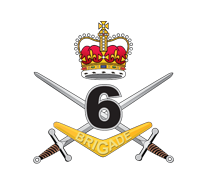
The 6th Combat Support Brigade is an Australian Army brigade. First formed in 1912 as a Militia formation to provide training under the compulsory training scheme, the brigade was re-raised during the First World War as an infantry unit of the all volunteer Australian Imperial Force. It subsequently served at Gallipoli and in France and Belgium on the Western Front. In the 1920s, as part of a reorganisation of the Australian Army, it became part of the 3rd Military District of the Citizens Military Force, encompassing units from Victoria and South Australia. In 1991, it became part of the Ready Reserve Scheme, based at Enoggera Barracks, in Brisbane, Queensland, before being disbanded in 1996 when the scheme was discontinued. The brigade was re-raised on 1 March 2010 to oversee the Army's command support and intelligence, surveillance, target acquisition and reconnaissance units.

The 14th Brigade was an infantry brigade of the Australian Army. Originally raised in 1912 as a Militia formation, it was later re-raised in 1916 as part of the First Australian Imperial Force for service during World War I, the brigade was assigned to the 5th Division and served on the Western Front between 1916 and 1918 before being disbanded. It was later re-raised as part of the Australia's part-time military forces during the inter-war years. During World War II, the brigade was a Militia formation and it took part briefly in the New Guinea campaign with elements of the brigade undertaking defensive duties around Port Moresby before taking part in the fighting along the Kokoda Track and around the Japanese beachheads at Buna–Gona. The brigade was disbanded in mid-1943 as part of a rationalisation of Australian military forces as a result of manpower shortages.
The 2nd Motor Brigade was a formation of the Australian Army during the interwar years and World War II. Initially raised in 1921 as the 2nd Cavalry Brigade in New South Wales, it was a part-time formation of the Militia. It consisted of three light horse regiments spread across several depots across the Hunter Valley and northern part of the state. During World War II, the brigade was mobilised for defensive duties in December 1941, and assumed positions along the northern coast to defend against a possible invasion. In early 1942, the brigade was converted into a motorised formation, and was redesignated as the 2nd Motor Brigade. In April 1943, when the threat of invasion had passed, it was disbanded and its manpower reallocated.

The 10th Brigade was an infantry brigade of the Australian Army. Originally formed in 1912 as a Militia formation, the brigade was re-raised in 1916 as part of the expansion of the Australian Imperial Force following the end of the Gallipoli campaign. It subsequently saw service on the Western Front in France and Belgium during the First World War. After the war it was disbanded but was re-raised in 1921 as a part-time formation based in the state of Victoria. During the Second World War the brigade was used in a garrison role in Australia before being disbanded in 1942.
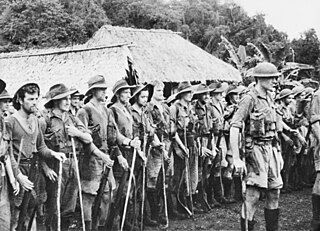
The 30th Brigade was a brigade-sized infantry unit of the Australian Army. Formed in December 1941, as part of the Militia, the unit was raised for service during the Second World War. Established in response to Japan's entry into the war, the brigade's subordinate units were established in several Australian states. Some of these had already been dispatched to New Guinea before the brigade's headquarters was established, although the majority arrived there in early 1942. Following their arrival, the brigade initially provided garrison troops to Port Moresby before later taking part in the fighting along the Kokoda Track during which elements took part in delaying actions around Kokoda and Isurava, before being relieved by units of the Second Australian Imperial Force. After the campaign began to turn in favour of the Australians, the Japanese withdrew north towards their beachheads around Buna and Gona, and elements of the brigade were recommitted to the fighting. In early 1943, the 30th Brigade was withdrawn back to Australia and was disbanded in July 1943, with its personnel being redistributed to other formations.
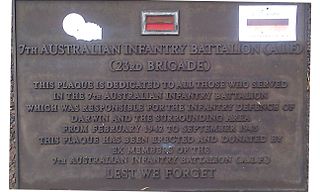
The 23rd Brigade was a brigade of the Australian Army. It was briefly raised in 1912 as a Militia formation providing training as part of the compulsory training scheme. Later, it was re-formed in July 1940 for service during the Second World War, the brigade was initially a formation of the Second Australian Imperial Force assigned to the 8th Division; however, after its sub units were captured by the Japanese in 1942 it was reformed with Militia battalions and was mainly used in a garrison role around Darwin, in the Northern Territory, until late in the war when it was committed to the fighting against the Japanese on Bougainville. It was disbanded in 1946.
The 31st Brigade was a formation of the Australian Army during World War II. Raised in January 1942, amidst concerns of a Japanese invasion of Australia, the brigade was tasked with defending the eastern New South Wales coast around Botany Bay and Cronulla. Initially consisting of just two infantry battalions, after several months a third battalion was assigned to bring it up to strength. The formation was only short-lived and was disbanded in September 1942, having never seen combat, with its battalions being reassigned to other formations.
The 28th Brigade was a formation of the Australian Army during World War II. Raised in April 1941, the brigade consisted of Militia units who were assigned to carry out defensive duties on the New South Wales Central Coast. After being mobilised for war in December 1941, the brigade mounted defensive duties throughout 1942 and 1943, defending against a possible Japanese invasion. As this threat passed, the brigade's role diminished throughout 1943. Eventually, the brigade was disbanded in December 1943 having never seen combat. Its constituent units either amalgamated with others, or broken up as reinforcements.

The 2/33rd Battalion was an infantry battalion of the Australian Army during the Second World War. It was formed as part of the Second Australian Imperial Force in the United Kingdom in June 1940 as the "72nd Battalion" to create the 25th Brigade, which eventually became part of the 7th Division. After the threat of invasion had passed, the battalion was transferred to the Middle East in early 1941, and after a period of garrison duty in the Western Desert, the battalion fought against the Vichy French in the invasion of Syria and Lebanon.

The 2/4th Pioneer Battalion was a unit of the Australian Army raised for service during the Second World War. A pioneer unit, the battalion undertook both infantry and engineer tasks. Despite being raised early in the war, the battalion did not see action until the final months, taking part in the Borneo campaign where, as part of the 1st Beach Group, it fought against the Japanese in support of the 9th Division. It was disbanded in early 1946 following the end of hostilities.















